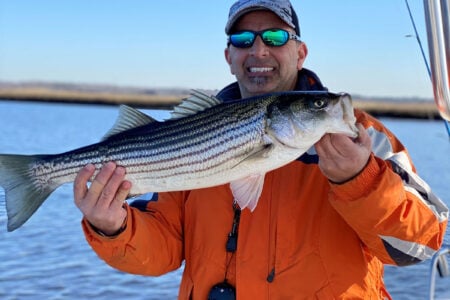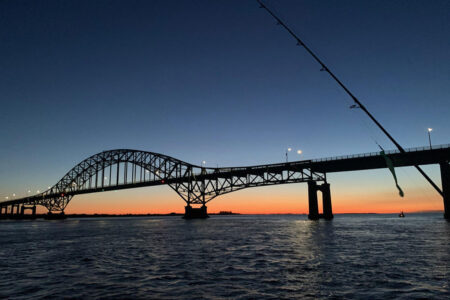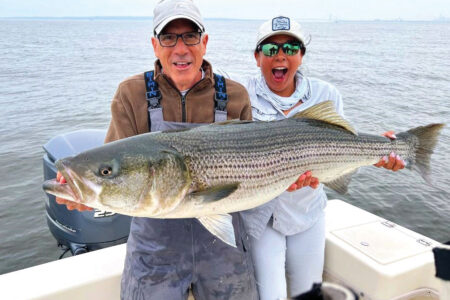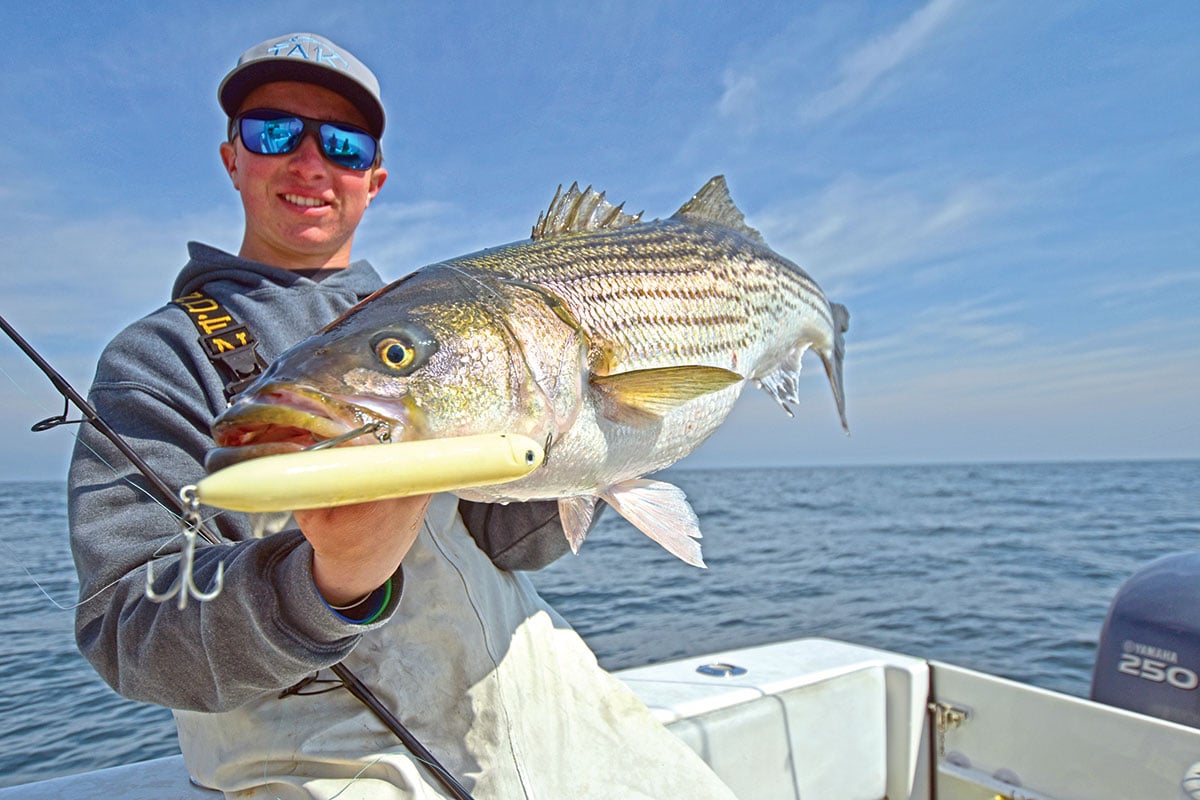
By bait, plug or spoon, it’s the best time of year to own a boat at the Jersey Shore.
The arrival of October means anglers far and wide set their minds on the infamous fall striper migration up and down the Jersey Coast. During this run anglers will often experience some of their best and worst days, as for the bass are feeding heavily and will follow the bait wherever it may take them.
There are a number of different ways to go about targeting these migratory fish as they move past, including throwing plugs into feeds, jigging on large schools of fish, and trolling when the bite is tough and the fish are more spread out.
Back To Schools
Finding fish in the fall can sometimes be challenging, especially early on during the run. Most of the time the bigger fish will move through first, feeding on the remainder of the adult bunker that sticks around the Jersey coastline throughout the summer. This typically happens around the last week of October or first week of November.
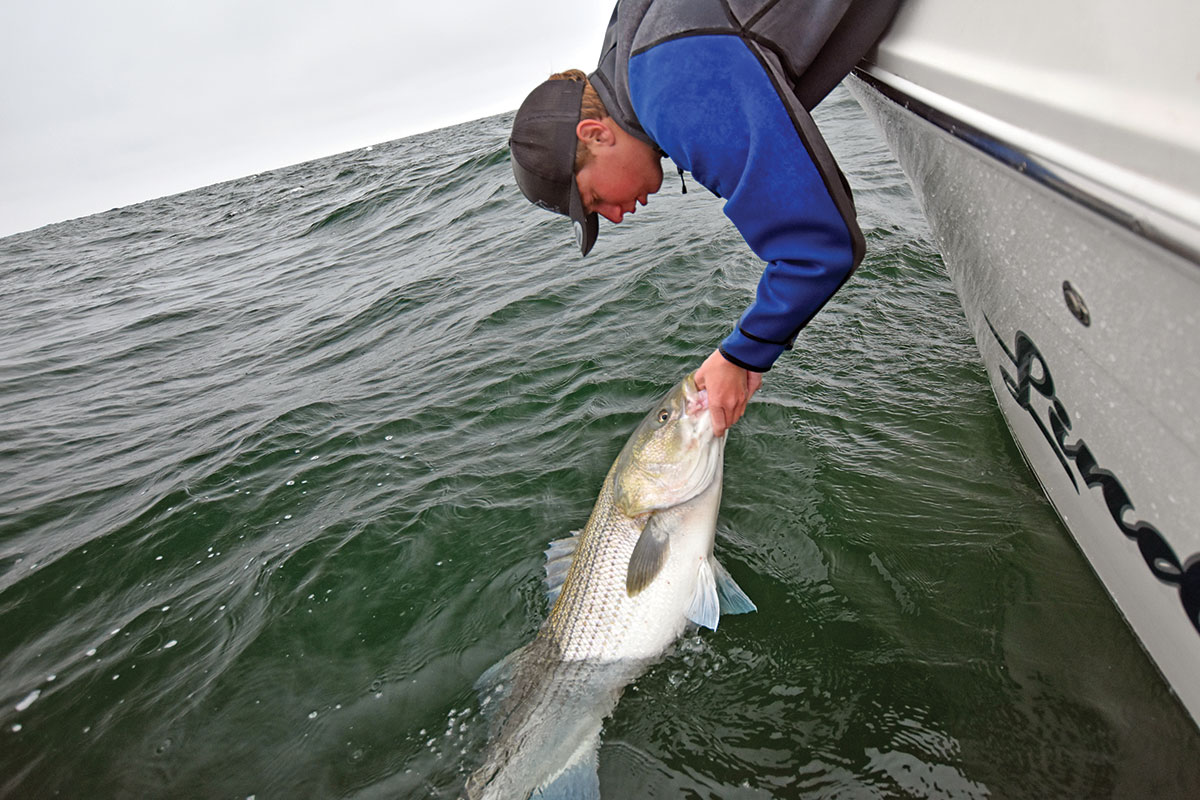
When targeting these fish, look for tightly packed schools of adult bunker near the surface. Oftentimes you will see the disturbed water from the bunker being so tightly packed, with the bunker occasionally darting out of the water in different directions when the stripers come up and feed. Once you have found this, you are ready to start fishing the pod. The two most successful tactics for targeting these bigger fish are throwing big plugs, and livelining.
For throwing plugs you want a longer rod than your typical boat rod to add distance to your casts and to support the weight of some of the bigger plugs. A 7-1/2- to 8-foot medium heavy rod is ideal for longer casts and better hookups, which leads to more hookups and more landed fish. Big metal lip plugs are always very good producers during this time, especially for drawing strikes when topwater plugs like pencil poppers just aren’t getting the job done. CCW, JP lures and GRS are among some of my favorite plugs to throw in these situations. When tossing these big plugs you are going to want 40-pound braid main line with a 50-pound leader.
For livelining, castnetting enough bunker for the livewell to last an entire session is best. If you’re snagging baits, a 7- or 7-1/2-foot medium heavy rod is ideal, paired with a 5000 or 6000 size class reel. While “snag and drop” became popular in the 2000s, the better alternative is snagging the bunker and bringing it in to hook on another rod with an 8/0 circle hook, greatly decreasing the chances of gut hooking while giving them a much higher chance of survival. You want to hook the bunker in the nose, making sure the bait is secure on the hook. These fish will sometimes smash a live bait several times before eating it, and it is important your hook stays not only in the bait but sitting properly to ensure your hook does not turn back into your bait when you attempt to hook a fish.
For both of these applications 40-pound braid main line with a 40-pound leader is ideal, sometimes going down to 30-pound leader if the bite is tough.
On The Troll
If the bait is scarce, trolling is always an effective tactic to target fall stripers on the move. When choosing where to troll you want to target areas with a lot of structure and are notorious for holding bass. These fish will oftentimes follow very similar migration paths year after year, so if there is a particular spot you have caught in previous years that is always a good place to start. When trolling you want to stay right around 3.2 knots, depending on wind and current.
Once you have your starting direction it is crucial to run your baits right off the back of the boat to make sure they are swimming properly with the speed. Once you have found the sweet spot, you’re ready to drop back and wait for a strike. There are two main players when it comes to trolling lures for stripers. First off, you have the traditional bunker spoon. Spoons are a great way to target trophy sized striped bass in the spring and fall, and if trolled right can get bit on days when nothing else will. Oftentimes when choosing the right color and size spoon to troll can simply be a process of elimination.
Every day is different and it is important to be trolling the right spoons for any given day. Generally, starting out with one white and one green spoon is the safest bet. If you get more than two bites on one color before the other, that is a sign it may be time to switch the nonproductive color out for another one of the spoon that is producing.
Mojos are also a great tool to target these fish while trolling. You can troll single mojos or two on a tandem rig as both produce fish, but like the spoons fish will sometimes prefer one over the other. In the deeper water it is important to choose the correct size mojo to maximize your chance of getting bites. When fishing mojos the most efficient way to do it is to fish two tandem rigs and two singles. The tandems can be fished off the side in outrodders, and the singles down the middle. Chartreuse and white are the two colors to be fishing, and until the fish show a preference for one over the other drop back one tandem and one single in both colors.
A good weight combination for the tandems is a 24-ounce head in front with an 8-ounce head trailing. For the singles you want to cover as much of the water column as possible, so pulling one 24-ounce head and one 12-ounce head is ideal. You want to get up to your speed before sending the mojos back. Once you are up to speed drop the mojos back until they hit bottom, then thumb the spool so the bait begins to swim. After holding the spool for about 10 seconds drop the mojo back to the bottom a second time and you are ready to set the drag and begin fishing.
Throttle Down
The window of larger fish here in the fall is normally fairly brief, so it is important to check all of your knots, hooks, and gear to ensure you capitalize on as many bites as possible. Once most of the bigger fish move on, the madness usually begins along the Jersey Shore as huge schools of migrating bass anywhere from 25 to 35 inches storm the coast gorging on all of the available baitfish. Peanut bunker, mullet, and sand eels are the most common bait these fish are feeding on, so it’s crucial to figure out which bait the fish are feeding on when picking your presentation. Most times if the bass are feeding close to the beach they will be on either peanut bunker or mullet, and if they are feeding farther offshore they are on sand eels.
When trying to locate these fish, the first and most important thing to look for is birds working. They can be seen from a good distance away and are usually a telltale sign that there are fish feeding directly under them. When approaching a large group of birds with fish under them, you always need to watch carefully for where the fish are feeding, stopping well short of the action to ensure you don’t get too close and shut the feed down. Once within casting distance, take the boat out of gear but leave the engine running. A lot of the times these fish will be moving fairly quickly, and you may only be able to get two or three casts in before you have to reposition to get back in casting range.
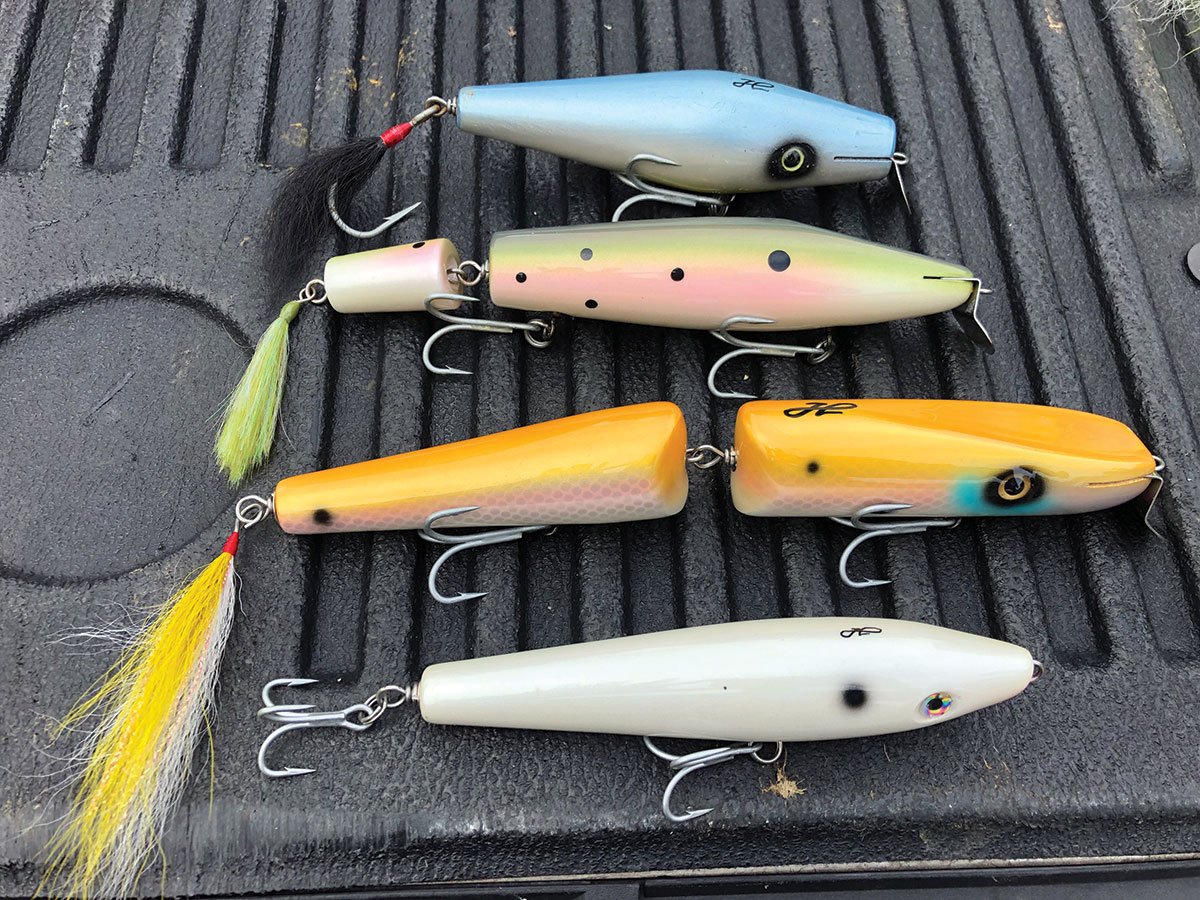
Topwater plugs like the Tsunami Talkin’ Popper and other smaller pencil poppers are deadly when the fish are feeding heavily on peanuts and mullet up top like this. When they won’t commit to topwater, throwing a smaller metal lip along with other hard baits such as smaller Daiwa SP Minnows that imitate what the fish are feeding on can help you get more bites. A lot of the fish in these situations are going to be a little smaller so downsizing your tackle will allow you to throw some of the smaller baits better along with letting you enjoy the fight. A 7-foot medium action rod paired with a 3000 or 4000 size class reel spooled with 25- to 30-pound braid and 30-pound leader will easily get the job done.
When bass are on sand eels you are going to want to throw a bait with a much slimmer profile to properly imitate what they are feeding on. Light jigs and slim plastics such as smaller RonZs in natural colors worked fast just below the surface are always good producers. Just remember that when the fish are feeding on sand eels they can become finicky, so going down to 20- sometimes even 15-pound leader is necessary to entice a strike.
Catching these fish in a topwater feed is one of the most exciting and entertaining ways to do it, but these feeds don’t always last forever. When the fish start moving down, you should look to jigging to keep the action steady. Working heavier swim shads and plastics down deeper is always a good way to keep catching these fish even after they push down deep. Small jigging spoons and other metals can also produce a number of bites when the fish are down in the water column. The same tackle used for throwing topwaters is ideal for this, although a heavier rod may be needed depending on how heavy the lures are.
When jigging you want to slowly cruise around paying close attention to your sonar. Once you mark the school of fish put the boat in neutral and drop your jigs back. Leaving the engines running in this situation is also a must because again like the topwater feeds these fish are going to be moving and you may only get one or two drops before having to reposition back on to the school.
Taking advantage of this run is a great way to be able to see some of the best striper fishing New Jersey has to offer, and with a little preparation and the right tools anyone can get in on the action.

